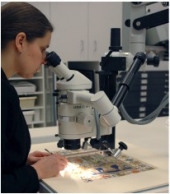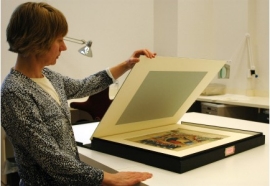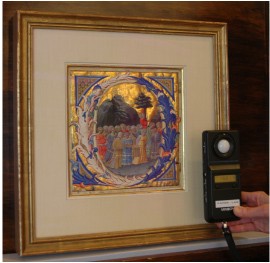Artists’ recipes can be found in books such as Cennino Cennini’s Craftsman's Handbook (Il Libro dell'Arte) written in 1390. Such texts describe raw materials and their sources and provide advice for how to make drawings, paintings and sculpture.
Illuminated manuscript designs are often drawn on the animal skin using leadpoint ruling lines and thin ink washes. A glue-and-chalk ground called bole is applied to vellum before laying gold or silver leaf. Paints are mixed using various pigments and binders.
Recreating artists' paints using traditional methods helps scholars to recognize and understand the materials on the artworks themselves. Technical information can also provide valuable insight into an artist’s workshop techniques and relationships with other artists.
Illuminated Manuscripts
What Is an Illuminated Manuscript?
Illuminated manuscripts are hand-written books with painted decoration that generally includes precious metals such as gold or silver. The pages were made from animal skin, commonly calf, sheep, or goat. Illuminated manuscripts were produced between 1100 and 1600, with monasteries as their earliest creators. Wealthy patrons also wanted these illustrative works for personal libraries and encouraged the formation of private workshops that flourished in French and Italian cities between the 13th and 15th centuries. The decline of the illuminated manuscript tradition coincided with the ability to mass produce printed text and the increasing numbers of literate people who wanted secular as well as religious books.
lluminated manuscripts were created in various sizes depending on their intended use. The choir pages, below left, were large so that a group could simultaneously view the pages from a distance. The palm-sized prayer book, below right, was produced for a wealthy patron to use for personal worship.

Left: Master of Imola (artist), The Nativity with Six Dominican Monks, 1265/1274, miniature on vellum, National Gallery of Art, Rosenwald Collection. Right: Flemish 15th Century (artist), Book of Hours, 1440 manuscript with 6 illuminated pages in red and brown ink and gouache and gold on vellum.
What Materials Are Used to Paint a Manuscript Leaf?
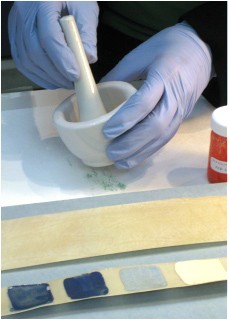
Recreating an artist palette on vellum using traditional pigments and binding materials
Preserving Illuminated Manuscripts: Stabilizing Treatment
Paint used to illuminate manuscripts can sometimes become detached from the vellum. The conservator aligns and re-adheres fragile paint flakes with the help of a microscope. Photography and written documentation of the treatment ensure that future caretakers understand where fragile areas exist and how they have been cared for in the past.
Attributing Manuscript Leaves
Curators and conservators often work together to examine an artist’s style, techniques, and choice of materials. Looking at artworks under a microscope can reveal minute details that cannot be seen with the unaided eye. Below are two works of art whose similarities in their brushstrokes reveal them to be painted by the same artist, known as the Master of Imola.
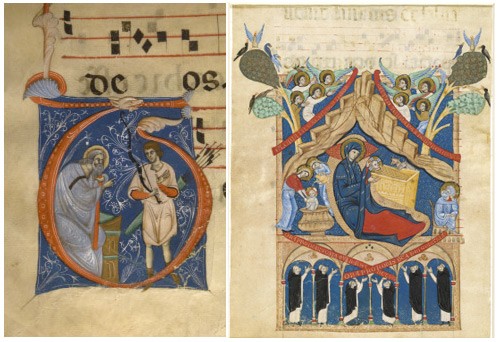
Left: Detail of Master of Imola (artist), The Three Maries at the Tomb with the Angel of the Resurrection, and Isaac Sending Esau Out to Hunt, c. 1275, miniature in tempera on vellum in an eight-leaf fragment from an antiphonary, National Gallery of Art, Gift of Mr. Ladislaus and Beatrix von Hoffmann
Right: Master of Imola (artist), The Nativity with Six Dominican Monks, 1265/1274, miniature on vellum, National Gallery of Art, Rosenwald Collection

Left to right: Detail of Easau's hand; Detail of Esau's head; The thin-white elongated brushstrokes used to create fingers on each hand are nearly identical in style and technique. Similar thin-white brushstrokes are applied to eyebrows and lips. Small, round white dots centered in each eye are also consistent.
Subtle details such as the eyes of the water bearer’s face and the white lines used to highlight the fingers were instrumental in helping attribute this leaf to the artist known as Master of Imola.
Storage
Single manuscript pages are stored in protective window mats, shown above, so that their fragile painted surfaces are kept safe. The mats are placed in sturdy boxes in monitored storerooms that maintain an ideal temperature and relative humidity. A stable climate is especially important for illuminated manuscripts because animal skin readily expands and contracts in fluctuating humidity.
Exhibiting Illuminated Manuscripts
Knowing what materials and technique artists used helps conservators determine if objects are especially fragile or sensitive to light, moisture, or pollutants. Limiting the length of exhibitions for sensitive objects ensures that many generations to come will be able to experience their wonder.
Protecting artworks from light exposure is a priority for their long term preservation. Conservators work closely with curators and scientists to establish exhibit guidelines that require low light levels and short exposure times.
Conservators work with framers to build climate resistant enclosures that protect artworks from environment pollutants, fluctuating temperatures and humidity during exhibit. Sealed packages also ensure that works are protected during travel and display at other institutions.
For further information on Illuminated Manuscripts, see the outline of a project on advanced imaging that identifies the materials used when pages like the one in this article was created.
Conservation Division
National Gallery of Art
2000B South Club Drive
Landover, MD 20785
[email protected]
